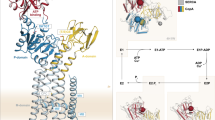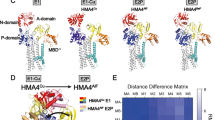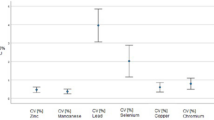Abstract
Human Menkes disease and the murine Mottled phenotype are X-linked diseases that result from copper deficiency due to mutations in a copper-effluxing ATPase, designated ATP7A1–5. Male mice with the Mottled-Brindled allele (Mo-brJ) accumulate copper in the intestine, fail to export copper to peripheral organs and die a few weeks after birth. Much of the intestinal copper is bound by metallothionein (MT)6. To determine the function of MT in the presence of Atp7a deficiency, we crossed Mo-brJ females with males that bear a targeted disruption of the Mt1 and Mt2 genes (Mt −/−)7. On an Mt −/− background, most Mo-brJ males as well as heterozygous Mo-brJ females die before embryonic day 11. The lethality in Mo-brJ females can be explained by preferential inactivation of the paternal X chromosome in extraembryonic tissues8 and resultant copper toxicity in the absence of MT. In support of this hypothesis, cell lines derived from Mt−/−, Mo-brJ embryos are very sensitive to copper toxicity.
This is a preview of subscription content, access via your institution
Access options
Subscribe to this journal
Receive 12 print issues and online access
$259.00 per year
only $21.58 per issue
Buy this article
- Purchase on SpringerLink
- Instant access to full article PDF
Prices may be subject to local taxes which are calculated during checkout
Similar content being viewed by others
References
Vulpe, C., Levinson, B., Whitney, S., Packman, S. & Gitschier, J. Isolation of a candidate gene for Menkes disease and evidence that it encodes a copper-transporting ATPase. Nature Genet. 3, 7–13 (1993).
Chelly, J. et al. Isolation of a candidate gene for Menkes disease that encodes a potential heavy metal binding protein. Nature Genet. 3, 14–19 (1993).
Mercer, J.F. et al. Isolation of a partial candidate gene for Menkes disease by positional cloning. Nature Genet. 3, 20–25 (1993).
Levinson, B. et al. The mottled gene is the mouse homologue of the Menkes disease gene. Nature Genet. 6, 369–373 (1994).
Mercer, J.F.B. et al. Mutations in the murine homologue of the Menkes gene in dappled and blotchy mice. Nature Genet. 6, 374–378 (1994).
Hunt, D.M. & Port, A.E. Trace element binding in the copper deficient mottled mutants in the mouse. Life Sci. 24, 1453–1466 (1979).
Masters, B.A., Kelly, E.J., Quaife, C.J., Brinster, R.L. & Palmiter, R.D. Targeted disruption of metallothionein I and II genes increases sensitivity to cadmium. Proc. Natl. Acad. Sci. USA 91, 584–588 (1994).
West, J.D., Frels, W.I., Chapman, V.M. & Papaioannou, V.E. Preferential expression of the maternally derived X chromosome in the mouse yolk sac. Cell 12, 873–882 (1977).
Kägi, J.H.R., Evolution, structure and chemical activity of class I metallothioneins: an overview, in Metallothionein III: Biological Roles and Medical Implications (eds. Suzuki, K.T., Imura, N. & Kimura, M.) 29–55 (Birkhäuser Verlag, Bäsel, Switzerland, 1993).
Iszard, M.B. et al. Characterization of metallothionein-l-transgenic mice. ToxicolAppl. Pharmacol. 133, 305–312 (1995).
Michalska, A.E. & Choo, A.K.H. Taigeted and germ-line transmission of a null mutation at the metallothionein I and II loci in mouse. Proc. Natl. Acad. Sci. USA 90, 8088–8092 (1993).
Kelly, E.J. & Palmiter, R.D. Metallothionein-I and -II protect against zinc deficiency and zinc toxicrty. J. Nutr. (in the press).
Cuthbert, J.A. Wilson's disease: a new gene and an animal model for an old disease. J. Investig. Med. 43, 323–326 (1995).
Palmiter, R.D. & Findley, S.D. Cloning and functional characterization of a mammalian zinc transporter that confers resistance to zinc. EMBO J. 14, 639–649 (1995).
Hunt, D.M. Primary defect in copper transport underlies mottled mutants in the mouse. Nature 249, 852–854 (1974).
Database (MGD), Mouse Genome Informatics Project, The Jackson Laboratory, Bar Harbor, Maine. World Wide Web (URL: http://www.informatics.jax.org) (July, 1995).
Philips, M., Camakaris, J. & Danks, D.M. Comparisons of copper deficiency states in the murine mutants blotchy and brindled. Biochem. J. 238, 177–183 (1986).
Andrews, G.K., Adamson, E.D. & Gedamu, L. The ontogeny of murine metallothionein: comparison with the α-fetoprotein gene. Dev. Biol. 103, 294–303 (1984).
Shao, C. & Takagi, N. An extra maternally derived X chromosome is deleterious to early mouse development. Development 110, 969–975 (1990).
Harrison, K.B. X-chromosome inactivation in the human cytotrophoblast. Cytogenet Cell. Genet. 52, 37–41 (1989).
Migeon, B.R., Wolf, S.F., Axelman, J., Kaslow, D.C. & Schmidt, M. Incomplete X chromosome dosage compensation in chorionic villi of human placenta. Proc. Natl. Acad. Sci. USA 82, 3390–3394 (1985).
McArdle, H.J. & Eriich, R. Copper uptake and transfer to the mouse fetus during pregnancy. J. Nutr. 121, 208–214 (1991).
Palmiter, R.D., Sandgren, E.R., Koeller, D.M. & Brinster, R.L. Distal regulatory elements from the mouse metallothionein locus stimulate gene expression in transgenic mice. Mol. Cell. Biol. 13, 5266–5275 (1993).
Palmiter, R.D., Findley, S.D., Whitmore, T.E. & Durnam, D.M. MT-III, a brain-specific member of the metallothionein gene family. Proc. Natl. Acad. Sci. USA 89, 6333–6337 (1992).
Freshney, R.I., in Culture of Animal Cells: A Manual of Basic Technique, 2ndEdn. 107–126 (Alan R. Liss, Inc., New York, 1987).
Mossman, T. Rapid colorimetric assay for cellular growth and survival: application to proliferation and cytotoxicity assays. J. Immunol. Methods 65, 55–63 (1983).
Author information
Authors and Affiliations
Rights and permissions
About this article
Cite this article
Kelly, E., Palmiter, R. A murine model of Menkes disease reveals a physiological function of metallothionein. Nat Genet 13, 219–222 (1996). https://doi.org/10.1038/ng0696-219
Received:
Accepted:
Issue date:
DOI: https://doi.org/10.1038/ng0696-219
This article is cited by
-
Metallothioneins regulate ATP7A trafficking and control cell viability during copper deficiency and excess
Scientific Reports (2020)
-
Physiological copper exposure in Jurkat cells induces changes in the expression of genes encoding cholesterol biosynthesis proteins
BioMetals (2013)
-
Redox biochemistry of mammalian metallothioneins
JBIC Journal of Biological Inorganic Chemistry (2011)
-
Type I interferon receptor-independent and -dependent host transcriptional responses to mouse hepatitis coronavirus infection in vivo
BMC Genomics (2009)
-
Morbus Wilson
Der Gastroenterologe (2008)



